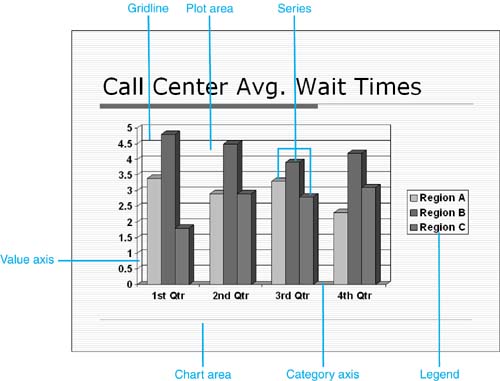Understanding Charts in PowerPoint
Understanding Charts in PowerPointYou can use Microsoft Graph to create charts in your presentation, or you can insert charts created in another application, such as Excel. Using Microsoft Graph inside PowerPoint is the easiest way to create a graph, but doesn't offer any calculation or formula capabilities for your chart data. If you've already created a chart in Excel or you need to analyze complex data, it's best to insert an Excel chart. NOTE For the sake of consistency, we use the term chart throughout this chapter to match PowerPoint's interface ”even though the application you use to create charts is called Microsoft Graph. Essentially, chart and graph are synonyms for any kind of graphical representation of numeric information. Before you start creating a chart using Microsoft Graph from within PowerPoint, you should become familiar with chart terminology. Table 11.1 lists these terms and their definitions. Table 11.1. Chart Object Terminology
Figure 11.1 shows some of these chart objects. Figure 11.1. Learn the basic objects of a chart before you create one. |
EAN: 2147483647
Pages: 261
- ERP System Acquisition: A Process Model and Results From an Austrian Survey
- The Second Wave ERP Market: An Australian Viewpoint
- A Hybrid Clustering Technique to Improve Patient Data Quality
- Relevance and Micro-Relevance for the Professional as Determinants of IT-Diffusion and IT-Use in Healthcare
- Development of Interactive Web Sites to Enhance Police/Community Relations
